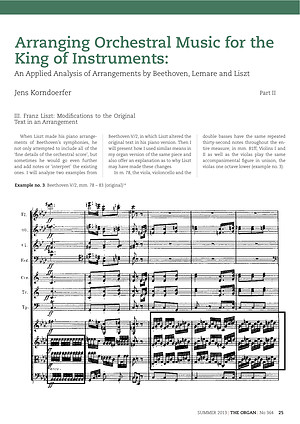Arranging Orchestral Music for the Pope of Instruments

Arrangements for keyboard instruments played a significant role in the musical life of the nineteenth and early twentieth centuries. Based on an analysis of writings and arrangements by Ludwig van Beethoven (i.e., the composer arranging his own works), Edwin H. Lemare (i.e., a prolific arranger for the organ) and Franz Liszt (i.e., a prolific arranger for the piano), this paper discusses their respective reasons for arranging and their techniques of arrangement.
Their reasons for arranging orchestral works for keyboard instruments range from the arrangement being beneficial to the original work (i.e., Liszt) to the arrangement being beneficial to the instrument for which the arrangement was written (i.e., Lemare). The discussion of technical aspects includes modifications of the original by the arranger (i.e., Liszt), techniques specific to the organ such as double pedal and playing with one hand on two manuals (i.e., Lemare) and the transfer of writing specific to one family of instruments to another one, e.g., the adaption of string writing to the piano (i.e., Beethoven).
The author has applied the results of his research in his own arrangement for organ of the Second Movement from Ludwig van Beethoven’s Fifth Symphony. Excerpts from this arrangement are presented after each analytical section, together with an explanation of the decision-making process during the making of the arrangement.
This paper concludes with an evaluation of the benefits of arrangements for the organ in today’s music scene.
- Part I: The Organ. 363 (2013): 48-52.
- Part II: The Organ. 364 (2013): 25-36.
- Part III: The Organ. 365 (2013).